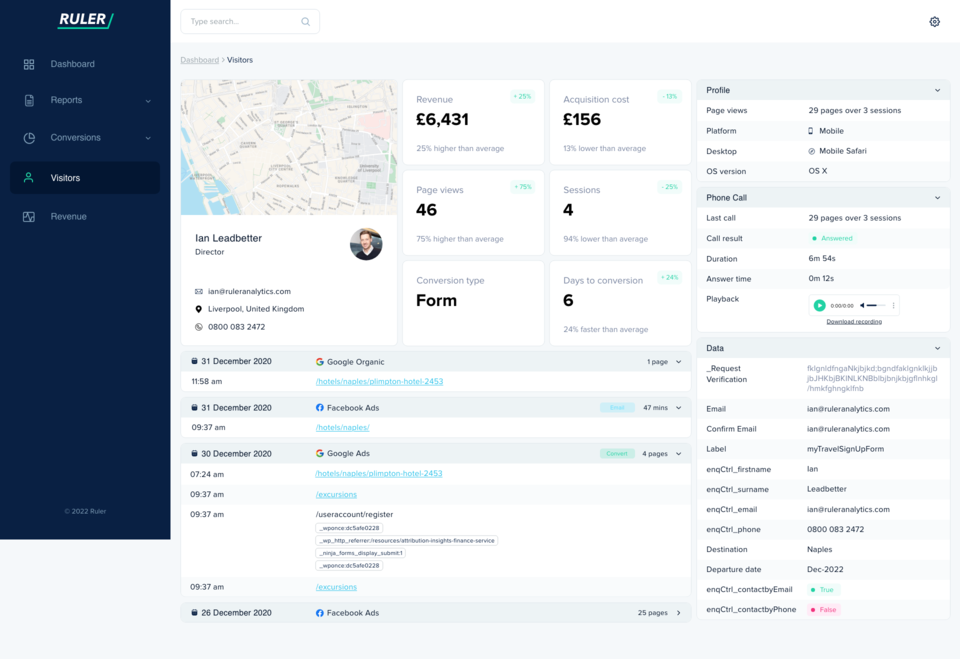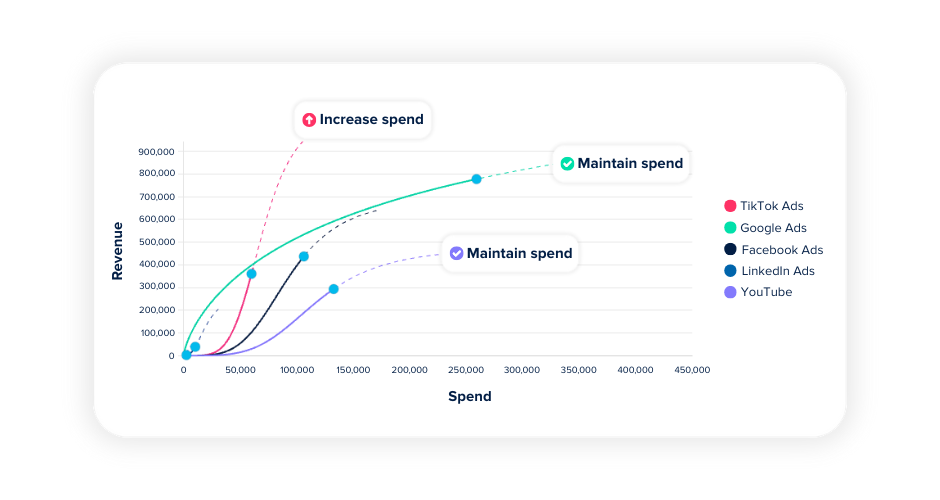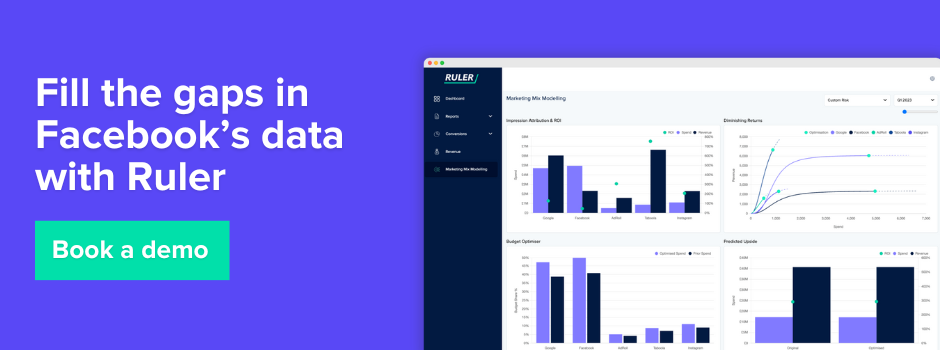We’re going to show you a few methods that you can put in place to help resolve the facebook ads google analytics discrepancy.
A common complaint among marketers is the ongoing struggle to accurately match Facebook conversion and click metrics with the data reported in Google Analytics 4.
Meta ads analytics discrepancies arise because Facebook ads and Google Analytics use completely different tracking methods, leading to numbers that don’t match between the reporting platforms.
There are many variables that contribute to the inconsistencies between Facebook and GA4, and the purpose of this guide is to help you understand these differences and learn how to interpret and navigate them effectively.
In this article, we’ll discuss:
💡 Pro Tip
Marketers have struggled to match data in Google Analytics and Facebook long before the iOS 14.5. Ruler acts as a bridge between Facebook and Analytics. It allows you to capture all interactions throughout a customer journey and provides a single source of truth about which ads, campaigns and landing are generating the most value.
Book a demo to learn more
Data discrepancies in analytics occur when two or more platforms report different figures for the same performance metrics.
This is a common issue when comparing data from platforms like Facebook Ads Manager and Google Analytics.
Each tool uses its own tracking methodologies, attribution models, and reporting timeframes, which naturally leads to inconsistencies.
Minor discrepancies are generally expected and usually not a cause for concern. It’s unrealistic to expect the numbers to match exactly.
However, significant variances can lead to inaccurate assessments of marketing performance, potentially resulting in poor decision-making.
If left unaddressed, these discrepancies may negatively impact campaign optimisation and your overall return on investment.
Discrepancies between Facebook and Google Analytics can happen for several reasons. GA4 sessions and Facebook clicks are tracked differently, and users may click the same ad multiple times. Differences in tracking methods, such as Google Analytics code not firing or view-through conversions not being tracked, can also contribute. Additionally, variations in conversion lookback windows, multiple conversions assigned by Facebook, incorrect pixel installation, and impacts from updates like Apple’s iOS 14.5 can all lead to mismatched reporting. Below is more information on each factor:
| Tracking aspect | Meta (Facebook) Ads | Google Analytics 4 |
| What it tracks | All ad interactions (clicks, likes, shares, comments) | Website interactions such as clicks, sessions, events, etc. |
| Attribution window | 7-day click / 1-day view (default) | 30-90 days (configurable) |
| Cross-channel tracking | Yes (logged-in Facebook users) | Limited (cookie-based only) |
| View-through conversions | Yes, includes impression-based conversions | No, click-through only |
| Conversion counting | No cookies required | Fully dependent on cookies |
| Privacy impact | Heavily impacted by tracking prevention (iOS) | Less impacted |
The biggest challenge advertisers face is that the number of clicks reported on Facebook don’t match the number of sessions in Google Analytics 4.
GA4 will only measure a session after a user has clicked on an ad and landed on your website, whereas Facebook will track any click engagement whether that be a like, share or comment.
Facebook reporting offers endless metrics to help measure the performance of your ads, with the most popular being “clicks” and “link clicks”.
“Clicks” in Facebook includes every interaction on an ad, such as a share, like or link click, to name a few examples.
“Link clicks”, on the other hand, only include the clicks that take place on an external link, say a landing page on your website.
As you can imagine, marketers often get these two metrics mixed up.
It’s not uncommon for a user to click on one of your ads multiple times, especially if they’re engaged in online shopping.
If, for some reason, a user clicks on your ad twice within a 30-minute session, Facebook would report those interactions as two separate clicks, whereas Google Analytics 4 would only display one session.
Google Analytics 4 uses first party cookies to capture data about web visitors.
If a user doesn’t accept cookies or has JavaScript disabled, then GA4 can’t track their touchpoints.
On the other hand, Facebook doesn’t require cookies to track clicks on an ad.
Users are required to log into Facebook, which makes it easy for the platform to attribute actions and track performance across different browsers and devices.
According to Facebook, more than 65% of conversions start on one device and are completed on another.
With that said, there’s a strong possibility that your Facebook is recording clicks and your Google Analytics isn’t, which is causing an inconsistency between your two platforms.
We’ve all done it.
Accidentally clicked on an ad on Facebook, and quickly closed the window before being redirected to a landing page.
In this case, it’s unlikely the GA4 tracking code has had a chance to load, thus leaving that session unrecorded.
Facebook, on the other hand, would have still counted the click, creating an inconsistency between both reports.
This point, in particular, is a huge inconvenience for marketers that advertise on mobile and is probably the main culprit for the data discrepancy between Facebook and Google Analytics.
By default, Facebook uses a 7-day window for click-through conversions and a 24-hour window for view-through conversions.
For acquisition events in Google Analytics 4, the lookback window is 30-days. You can also switch to 7-days if necessary. For all other conversion events, the maximum lookback window is 90, but you can reduce this to 30-days or 60-days.
If your sales cycle is longer than 7-days (chances are it is) there is a strong possibility that your conversions are going unattributed on Facebook.
When a conversion happens, Facebook will automatically attribute credit to the ad a lead viewed or engaged with – even if no clicks took place.
For example, let’s say a person sees a Facebook ad for your product but doesn’t click. Later that day, they visit your website using organic search and decide to make a sale.
In this case, Facebook would attribute this conversion to the ad that the person saw.
Google Analytics, however, wouldn’t be able to credit the view as its attribution only works if a user clicks on the ad and lands on your website, leading Google under attributing Facebook’s value.
It’s worth mentioning at this point that Facebook can’t differentiate between the two types of conversions, which means that they’re combined into a single data point.
It’s impossible to tell whether a lead converted as a result of a view or a click.
💡 Pro Tip
Marketing mix modelling can help businesses fill in the data gaps. Take Ruler, for example. Ruler’s marketing mix modelling assigns revenue attribution credit based on a user-level and considers ad views and clicks. It allows marketers to statistically analyse revenue over a period of time to discover exactly what generated those sales or closed deals.
Book a demo to learn more about Ruler’s MMM
Facebook is a people-based platform, so it can assign multiple conversions to the same user, whereas Google Analytics can only allocate one conversion per journey.
This point, in particular, causes a few headaches for businesses who rely on repeat purchases.
If you install the Facebook pixel incorrectly, then Google Analytics will fail to capture your data.
A common mistake is that marketers will install their tracking pixel on the landing page, which is linked in the ad creative.
Although, it’s unlikely that users will convert into a lead on their initial marketing touchpoint.
Related: Complete guide to tracking marketing touchpoints
Ideally, the best place to put your tracking pixel is on a page where only you converted users can reach. For example, a thank you page after filling out a form.
Apple’s iOS 14.5 introduced a new privacy feature that requires apps to obtain explicit user permission before tracking their activity across other companies’ apps and websites.
This feature, known as App Tracking Transparency (ATT), has significant implications for Facebook tracking and Google Analytics.
When users opt-out of tracking, it limits the amount of data that Facebook and other platforms can collect about their behaviour outside of the app. This can potentially affect data accuracy across the web, including data used by Google Analytics to track user behaviour on websites and apps.
Data discrepancies between platforms are common and expected. As mentioned earlier, different platforms use different tracking methods, so their numbers will never align perfectly.
Despite this, marketers still need to interpret their data effectively. Understanding what’s influencing business outcomes is essential for making informed budget decisions.
Fortunately, there are a few reliable solutions available that help clarify performance data, including insights into how Facebook is contributing to overall results.
Use URL parameters to measure your Facebook traffic and conversions more effectively in Google Analytics 4.
URL parameters are probably the most basic method to help bridge the gap between the data you see in Facebook and GA4. Auto-tagging is not available on Facebook, which means that you’ll need to manually add in your URL tags.
The most common (and easiest) way to generate URL parameters for your Facebook ad campaign would be to use Campaign URL Builder.
Make sure to use “facebook” as the Campaign Source and “paid” as the Campaign Medium. Google Analytics 4 defines paid search as “cpc”. If you were to add “cpc” to your Facebook ads, Google Analytics 4 would misattribute your traffic and conversion events to Google Ads.
Setting up URL parameters should help differentiate your paid traffic from any organic posts you’ve shared on Facebook.
Also, remember that URL parameters are case sensitive, so avoid using capital letters and spaces. If you’re not sure how URL parameters work, you can check out our guide on tracking links in Google Analytics 4.
One of the key limitations of Google Analytics 4 is its inability to accurately track individual customer journeys. Its attribution models are restricted to last click and data-driven attribution (DDA), both capped at a 90-day lookback window.
These models disproportionately credit lower-funnel touchpoints—such as brand search or retargeting—while upper-funnel efforts, like awareness campaigns on Facebook, often go unrecognised when a lead eventually converts.
DDA may sound more sophisticated, but with evolving privacy regulations (e.g., Safari deleting cookies after just 7 days), it can end up being just as restrictive as last click.
This creates a significant blind spot in understanding how users actually move through your funnel, and where Facebook really plays a role.
To bridge this gap, it’s better to track all click touchpoints across the full customer journey.
Take Ruler, for example. It uses first-party tracking tags to capture data like page views, UTM parameters, traffic sources, and conversions – all tied to individual users.
Ruler goes beyond just website activity by monitoring all types of conversion points, such as online forms, product demos, e-commerce sales, calls, and even in-person deals. This fills in the gaps left by GA4 and connects marketing activity with real sales outcomes.

By syncing marketing, conversion, and sales pipeline data, platforms like Ruler create a closed-loop system that ties ad spend directly to revenue.
It also imports campaign performance and click data from ad platforms, enabling you to calculate blended ROAS – so you’re not relying solely on skewed platform metrics from Meta or Google, which tend to favor lower-funnel results.
In short, layering a first-party attribution solution on top of GA4 allows you to go beyond aggregated data and limited attribution models. It gives you visibility into the upper-funnel activity – like Facebook campaigns – that helped drive conversions long before that final brand search or retargeting click.
Facebook and other social media platforms play a significant role in influencing purchasing decisions through impressions, not just clicks.
Often, users see an ad, engage with the brand later, and eventually convert.
However, as we discussed earlier, Google Analytics is unable to connect impressions with business outcomes. Meta allows for a 1-day view-through attribution window, but this is limited in effectiveness.
With longer customer journeys and the decline of third-party cookies, most conversions occur well after 24 hours, which means Facebook’s true impact is often underrepresented.
Marketing mix modelling provides a way to measure the influence of upper-funnel channels using aggregated data.
It has become increasingly important as marketers shift away from cookie-dependent tracking and look for more holistic measurement solutions. MMM uses statistical techniques, such as multivariate linear regression, to analyze historical data and estimate the impact of different marketing activities on revenue.

One of the key strengths of MMM enables exploration of both historical trends and future scenarios, offering actionable insights into available headroom in each channel, return on investment, and budget optimisation.
It’s important to remember that Facebook and Google Analytics 4 are two completely different platforms.
Sometimes, it’s not necessarily about fixing the discrepancies it’s about accepting the fact that both GA4 and Facebook are complementary tools working together to provide a better understanding of your marketing performance.
Using a tool like Ruler, you can go beyond basic conversion tracking in GA4 and Facebook to attribute revenue directly to your advertising efforts, which, in turn, will help you prove your impact on the bottom line and will allow you to manage and scale budget into the areas that have the potential to drive more revenue.
Ready to improve the quality of your reporting in Facebook and Analytics? Book a demo of Ruler Analytics and start attributing revenue directly to your advertising efforts.

Discrepancies happen because the platforms track and attribute activity differently. Google Analytics uses data-driven attribution by default, while Facebook uses a last-click model and may credit the same action to a view-through. Attribution windows vary, and GA4 doesn’t track impressions or view-through conversions, making totals appear inconsistent.
There are multiple causes why Facebook conversions and GA4 data don’t match: Facebook uses different attribution windows, includes view-through conversions, and may assign multiple conversions to the same user. GA4 relies on user-initiated sessions and excludes view-based data. iOS 14.5 has also limited Facebook’s ability to track users accurately across devices.
Neither is universally more accurate. The Facebook pixel and Google Analytics measure different things. Facebook Pixel focuses on ad performance within Meta platforms. GA4 gives a broader view of on-site behaviour. Since iOS 14.5, Facebook Pixel has faced more restrictions, particularly for tracking across devices and capturing conversion paths.
Yes, provided you use UTM parameters on your Facebook ad links. GA4 can track users who click from Facebook to your website. It cannot track in-app engagement such as likes or shares, nor can it capture view-through data from Facebook ads.
First-party tracking tools can fix tracking discrepancies between Facebook and GA4. Ruler Analytics captures click IDs, cookies, page views, and other first-party data. It links this information to real outcomes like revenue, allowing you to see how Facebook campaigns influence pipeline and sales, beyond what GA4 or Meta reports on their own.
There are a few differences between Facebook Pixel and GA4. Facebook Pixel is built for ad tracking and optimisation on Facebook and Instagram. It focuses on ad views, clicks, and conversions. Google Analytics tracks broader website performance, including traffic sources, user journeys, and on-site actions. Each tool serves a different part of the marketing stack.